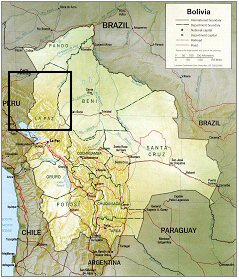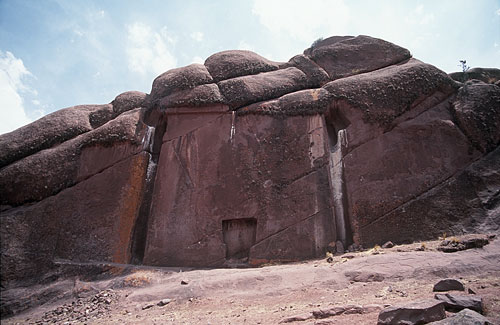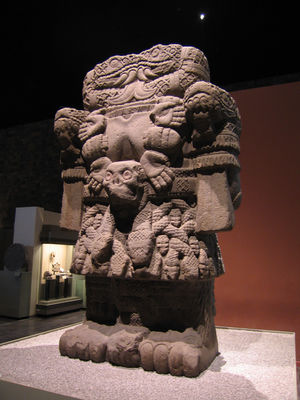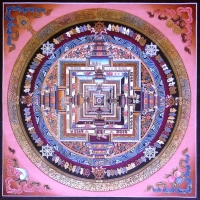 |
||
Lost Indian WorldsIndian TribesThe main focus of this article is to outline some historical and esoteric subjects related to the area of the Amazon, where many native tribes exist even today, some of them still unknown to us. The world is more importantly aware of the situation of various native people who live in isolation, and it is almost unbelievable that animals have better protection than groups of people living freely in nature, if their wish is to stay forever in isolation. A desire to live this way is the legitimate right - the basic right... The situation of these people is, however, appalling even in spite of the UNO's recommendations.Some information about Nazca lines in Peru and similar lines in Blythe (USA)The Madidi National Park
The National Geographic Journal classifies this area as "the reservation with the richest biodiversity in the world". The population consists of various groups, of uncontacted tribes too. In our history, Indians were abused by the influx of white settlers, who made slaves of them, and this is the dark side of the Latin America's history, but in North America it was not much too better. Many Indian tribes experienced their worst times particularly in the period of the so-called "rubber industry", when white migrants massacred them often. In the age when South America was first explored, some historians studied various native tribes that had never come into contact with the white culture. One of such tribes is the alleged Toromona group of people. During colonization, Spaniards did not have much luck to settle down in the area of the Amazon, where their main goal was to find a secret place called Paititi - an alleged hiding place of the Incas' biggest treasures, which the Incas concealed from Spaniards. There are also some historical records that confirm the fact that the Incas sealed subterranean tunnels in ritual ceremonies. Toromona Indians contacted the white civilization only in battle. It is known that they supported the Incas and there are historical records about this tribe, albeit it has never been found. One of their chieftains became famous in a battle against Spaniards and records say that his name was Tarano. Sometimes in the 20th century, Protestant missionaries observed, during their flight above the Amazon area, an isolated group of Indians somewhere near the Madre de Dios River and they came to a conclusion that it could be these Toromona people. However, later - after making a personal contact with them - they identified them as quite a different group (Araona), the number of which is about one hundred and they live in vulnerable conditions; however, they linguistically belong to the same group as the Toromona tribe.
A route from La Paz (capitol of Bolivia) to Pelechuca (a little city in the heart of Apolobamba) takes about 14 hours by bus and civilized people seldom visit such a wild region. This is certainly one of the reasons, too, why this area is known only so little. Apolobamba ends with the Amazon forest on its eastern side; many people died here, as they thought that the way to the legendary "lost city" must be here somewhere. The Madre de Dios forest starts here, too; when translated, it means the Mother (Madre) of (de) God (Dios). A well-known British explorer and scientist, Percy Fawcett, made several expeditions to the Amazon including the region of Apolobamba; in 1914, in the region of Mato Grosso (Brazil), he met an Indian tribe called Maxubis. These people were sun worshippers. We can speak about two types of "alienated" Indian or native tribes - 1) the isolated and 2) the uncontacted ones. Whereabouts of the isolated ones are known, but they refuse to come into contact with us. Albeit there may be some information about the uncontacted ones, the contact has never been established. The word "contact" is important to understand here, as it means more than just one meeting with a member of the majority race. For example, among the uncontacted is the Toromona tribe, too, but also Huaorani or Tagaeri, though the existence of the Toromona people requires an independent confirmation (we know that they existed, but without such a confirmation we cannot say that they have continued to exist up to the present day). On January 18, 2007, FUNAI (Fundašao Nacional do Indio), which is Brazil's national institute for protection of Indians, confirmed the presence of 67 tribes as the uncontacted ones, while in the year 2005 FUNAI reported only the number of 40. Albeit the Norwegian biologist Lars Hafskjold, who searched exhaustingly for this ethnic group (Toromona), became quite famous by his disappearance (1997), we still have no information about the present existence of the Toromona tribe. Uncontacted Tribes In South AmericaBrazil is the country with the biggest number of unknown ethnic groups in the world; their number in a group is about 20 to 400 aborigines. Bolivia: Sinabo/Kapuibo (Nahua), Yanaigua, Yuqui... Brazil: Apiaka, Apurina, Arua, Ava-Canoeiros, Guaja, Ingarune, Kanibo (Mayo), Kaniwa (Korubo), Karafawyana, Karitiana, Katawixi, Kayapo do Rio Liberdade, Kayapo-Pu'ro, Kayapo-Pituiaro, Kayapo-Kararao, Kulina, Maku (Nadeb), Mamaindé, Hi-Marima, Mayoruna, Miqueleno (Cujubi), Nereyana, Pakaa-Nova, Papavo group, then Pariuaia, Piriutiti, Sateré, Tupi-Kawahib (Piripicura), Uru-Eu-Wau-Wau, Wayapi (Yawapi), Yakarawakta... Columbia: Karabayo, Guaviare Macusa Ecuador: Huaorani Guyana: Wapishana French Guiana: Wayapi Peru: Morunahua, Parquenahua, Pisabo Surinam: Akulio Venezuela: Yanomami Paraguay: Totobiegosode clan Aramu MuruAramu Muru, a mysterious "door" found only recently (1996), can be photographed some 34 km from Puno, a city in Peru (3825 m above the sea level) near the lake Titicaca. After discovering this mysterious door, people became more interested in an Indian legend that spoke of a "gate to the land of Gods". The "stargate" near the lake Titicaca is a stone construction seven meters high and seven meters wide. The legend mentioned above speaks about an Incan priest, Aramu Muru, who belonged to the "seven rays cult"; one day he set off from Tiahuanaco to Cusco with a golden disc that represented the "Key Of The Seven Rays Gods". The disc had an alleged control over openings into subterranean tunnels. The priest disappeared on his way to Cusco and nobody has ever seen him since then.
Native people living nearby say that strange phenomena can be sometimes seen near this door - for example, high men accompanied by shining "balls of light", or "people" entering in and disappearing there. For those who live here, it is the clear evidence that legends really contain messages of gods. In addition, there are many historical records about tunnels in South America; these reports appeared immediately after Spaniards found that the Incas concealed most of their gold in the underground. More About HistoryThere are theories about an ancient migration of people from Asia to America. Nobody denies that the ancient history of South America can even today surprise with yet unknown secrets from the time many years preceding Christ, and that more civilizations co-existed here. Albeit scholars consider the Olmecs to be the oldest civilization here, other cultures like Pucara and Tiahuanaco (Tiwanaku) are often mentioned in historical context with the lake Titicaca, from the waters of which Manco Capac and Mama Ocllo arose - as the legends say - and founded the Inca Empire. In the middle of the lake, there is Island of the Sun with very ancient temple on it. Before the Inca Empire, Aymara people had developed
their civilization here - the ethnic group living in part of the Andes
(Peru and Bolivia) today. The heritage of this culture had also given
birth to Pachamama (Mother Goddess), who has her shrines in
Peru and Bolivia. The Incas absorbed Pachamama as their "dragon
goddess" of fertility, but the best translation is "Mother
Earth". The Aymara culture, which had prospered near the lake
Titicaca already some 1500 years before Christ, left various archeological
artifacts here. In the 15th century, the Incas conquered this civilization.
The AztecsThe Indian Goddess Kali has Her "Ghost Sister" in symbolism of the Aztec Goddess of Death - Coatlicue, which is also known as Teteo Inan (Mother of Gods). Coatlicue is pictured with a garland of dismembered human hands, hearts and skulls (picture on the left). The IncasMost historians agree that the Incas had 13 emperors: 1. Manco Capac, 2. Sinchi Roca, 3. Lloque Yupanqui, 4. Maita Capac, 5. Capac Yupanqui, 6. Inca Roca, 7. Yahuar Huacac, 8. Inca Viracocha, 9. Pachacuti-Inca-Yupanqui, 10. Topa Inca upanqui, 11. Huayna Capac, 12. Huascar, 13. Atahuallpa. The Inca Empire arose in the year 1200 AD and ended in 1535 AD. People in Peru, Bolivia and the rest of the Inca Empire were not all the "true Incas", but Indians of the Quechua and Aymara origin. The Incas were the elite governors of other race. They were convinced that they had come from a bearded messenger of gods, whom they worshipped as Viracocha. It is known that this is the reason why they welcomed Spaniards with such a great respect (as if they had already had met with a white race, for which they showed an evident respect); however, they made a mistake and their genocide followed soon. After the Spanish colonization overpowered everything, the Indians who refused to become Christians were made slaves. The Inca Empire was remarkable in that aspect that it was the territorially biggest Empire in the pre-Columbian America. Its political center was Cusco. The Empire did not last too long. Spaniards destroyed it in the 16th century also because the Empire was undergoing a severe crisis at the time when Atahualpa, who reigned in the North, and his brother Huascar, engaged in combats against each other. Thus, the Spanish conquistador Francisco Pizarro entered into historical records as the conqueror of the Inca Empire. The Incas, when they understood that they lost, ran away into the mountains. Later, many of them fell to slavery or were killed by diseases that Europeans brought there. ReligionThe concept of Viracocha or Apu Qun Tiqsi Wiraqutra, and, too, Con-Tici Viracocha - the god of the Incas, was taken from the culture of inhabitants living in the region before the Incas took it over. The legend has it that Viracocha had a son - Inti, and a daughter called Pachamama. The legend also speaks about deluge in which the two Inti's children were saved - the son Manco Capac and Mama Ocllo (mother of fertility), who rebuilt the world then. White IndiansChachapoya or Cloud People (Peru) is probably a deformed name which comes from Spaniards who adopted it from the Incas. The word Chachapoya defines a strange pre-Columbian ethnic group with a white skin. Only a little is known about them - for example, there are a few written records that they - a warlike people - lost their battle with the Incas. Cloud People welcomed the coming of Spaniards and wanted to use them in their continuing struggle against the Incas. A report about their white skin comes from a Spanish chronicler Pedro Cieza de Leˇn. They settled along a very big mountainous territory between the Maranon and Huallaga rivers in northeastern Peru. Cloud People had achieved domination over many parts of the pre-Columbian America, especially the area of the Andes and western part of the Amazon jungle. They could not resist diseases that Europeans brought to the region and scholars assume that they disappeared because of this. North AmericaNorth American Indians suffered (and suffer) equal extermination like the one that took place in South America and the US Government only denies this. Good articles are on the website of Republic of Lacotah where an American Indian activist, Russel Means, explains that USA is in hands of colonial powers. Means says that, "There is a great deal of propaganda about why the US broke away from England. But the fact is that George Washington, the largest landowner, along with slave owners, broke with England so that the original treaties of England with American Indians in the west would not have to be honored. The US broke with England, to invade the west and take the land." A must read about the Canadian Holocaust. When a white army battles
Indians and wins, it is called a great victory, but if they lose it
is called a massacre. -Chiksika, Shawnee.
|
||
|
|
||

 One of the most attractive and arcane natural parks is the Madidi
National Park, which was established on September 21, 1995. It covers
the area of almost 19,000 km2 and it is on the Bolivian-Peruan border
in Latin America. There is not even a full list of the flora and fauna
that exist in the area, as this place has been explored only a little
until now.
One of the most attractive and arcane natural parks is the Madidi
National Park, which was established on September 21, 1995. It covers
the area of almost 19,000 km2 and it is on the Bolivian-Peruan border
in Latin America. There is not even a full list of the flora and fauna
that exist in the area, as this place has been explored only a little
until now.
 Cordillera
Apolobamba is probably the least explored area in the Andes. It
is the line of hills - cordillera, the highest peak of which
is Chaupi Orco with height of 6044 m above the sea level. Many
people consider this particular part of the Andes to be a place where
El Dorado or Paititi can be found. Apolobamba has a
unique eco environment with unknown species of fauna and flora. Father
Miguel Cavello Balboa wrote about one such a city of gold and he described
Paititi as place protected by warrior women; he also mentioned the
Toromona tribe with notes that they did not have any mercy in killing.
Cordillera
Apolobamba is probably the least explored area in the Andes. It
is the line of hills - cordillera, the highest peak of which
is Chaupi Orco with height of 6044 m above the sea level. Many
people consider this particular part of the Andes to be a place where
El Dorado or Paititi can be found. Apolobamba has a
unique eco environment with unknown species of fauna and flora. Father
Miguel Cavello Balboa wrote about one such a city of gold and he described
Paititi as place protected by warrior women; he also mentioned the
Toromona tribe with notes that they did not have any mercy in killing.


